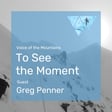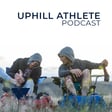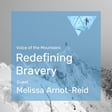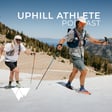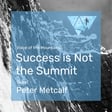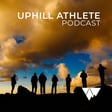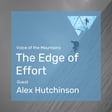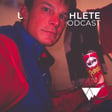Become a Creator today!Start creating today - Share your story with the world!
Start for free
00:00:00
00:00:01

Talking Metabolic Testing with Director of Sports Performance at UC Davis, Judd Van Sickle
Director of Sports Performance at UC Davis, Judd Van Sickle, talks about metabolic testing, fat adaptation, and aerobic deficiency with Scott Johnston.
Transcript
Introduction to Uphill Athlete Podcast
00:00:01
Speaker
Welcome to the Uphill Athlete Podcast. These programs are just one of several free services we provide to disseminate information about training for mountain sports. If you like what you hear and want more, please check out our website, uphillathlete.com, where you'll find many articles and our extensive video library on all aspects of training for and accomplishing a variety of mountain goals. You'll also find our forum, where you can ask questions of our experts and the community at large.
00:00:30
Speaker
Our email is coach at uphillathlete.com, and we'd love to hear from you. Welcome
Introduction to Aerobic Threshold and Metabolic Efficiency
00:00:36
Speaker
everyone to another episode of the Uphill Athlete Podcast. I'm your host, Scott Johnston, co-founder of Uphill Athlete. And today I've asked as a guest, Judd Van Sickle, who runs the human performance lab and testing lab at the University of California in Davis.
00:00:54
Speaker
And I've asked him to come on and talk to me about testing, about aerobic threshold, about bad adaptation, because we still get a tremendous number of questions about these things. And while, you know, and I think I've exhausted my
00:01:12
Speaker
ability to talk about many more because I think I've said everything I know how to say within books or on the website or in podcasts. And so I think having another voice to talk about these same things would be really helpful for folks to hear about it from a different angle. And I think that, you know,
00:01:33
Speaker
with the way I became, I just want to give people a little bit of a background that the way I found you was by searching around for a laboratory that could do metabolic efficiency testing, which there aren't very many of, as you know, and so that we could be, you know, have some place to recommend to our athletes that we coach. And I believe one of the first ones that I sent your way was Adrian Ballinger from
00:02:02
Speaker
not mistaken. Yeah, that's right. It was it was funny, the first couple of people I got either from your lab or through your book would always come in with the quote from your book, saying, we're not looking for a VO two max and all the all the different things. Yes, yes, I understand. I get it. But
00:02:22
Speaker
You're one of the few that gets it, so that's why I had to write those things. And since then, you've tested quite a few other uphill athletes. And for anybody who's in your area that needs to get tested, I would highly recommend they get in touch with you.
Judd's Sports Background and Career
00:02:37
Speaker
And we can put your contact information in the show notes after. But welcome, Judd. Thanks a lot for joining me. Yeah, thanks for having me.
00:02:47
Speaker
Well, let's start off with a little bit of your background. I know you had an extensive, you know, both running career and, um, you know, since then all the stuff you've done. So why don't you give us some rundown on your athletic background first? So, so sporting background, I was, I was track and field in high school and college. I ran division one walk on, not, not paid at Virginia Tech, the 400 meter runner primarily. Um,
00:03:14
Speaker
And after that, I went into cycling because I, I growing up and even through all my running, I was loved you down the bike. So I got into competitive cycling and I raised, I don't know, for 15 plus years, I was at category one on the road. I was definitely never going to go pro, but you know, that's physiology for you. Um, and then, uh, then I started having babies and you know, you, you can't really, I was not able to do 12 or 15 hours a week on the bike.
00:03:43
Speaker
and keep my fitness at the level it was. So I took a little time off and then I got into Spartan Race, obstacle course racing. I've been doing that for the last three or four years now. And that's been a huge change. It's been a lot of fun and something new and different where I can grow. Yeah, and I'm not very familiar with them. I'm sure some of the people listening will be, but give me just a brief rundown of what those things entail.
00:04:12
Speaker
So it's a running race with a lot of stuff thrown in the way. And that's something your audience will understand more. It is basically for the stuff I do a mountain race, but there'll be monkey bars and a rope climb and a spear throw and carrying a 60-pound sandbag up a hill and back down and all this different stuff thrown in the middle. So it's very much a compromised running workout up and down a mountain.
00:04:41
Speaker
How long can it last? So there's different distances. So it'll be anywhere from 30 minutes to three and a half hours. That sort of multidisciplinary thing fits pretty well into what we train people for. It's not too dissimilar to mountaineering and outline climbing. That's for sure. Right. It's not just the engine. Yeah.
00:05:05
Speaker
The engine under duress, which you guys get. Right. And then you've got to have some strength and power and some of the anaerobic qualities that we tend to de-emphasize a bit. And then you told me in one of our previous conversations that you had, tell me about this segue you took where you were working with Eric Haydn and Kent Bostic.
00:05:31
Speaker
So no, uh, so I, when this program here, I met UC Davis sports medicine. So underneath the health system, I run there's their sports performance and wellness program. And it was founded by Eric Haydn and Massimo Testa Eric. Yeah. Eric Haydn had, had a decent run in the Olympics, speed skating, um, or to call the gold medals. Um, and then, uh, Massimo Testa has a lengthy background with professional cycling.
00:06:01
Speaker
And they started this sports performance program trying to model the European model of sports medicine, the medicine of sports, not the American model, which is traumatology. So they're trying to look at the athlete holistically, not just injuries, but also looking at physiology and psychology and biomechanics and all this other stuff. So that's kind of the genesis of this program that I'm in here.
00:06:31
Speaker
And they've moved on since then, and I've stayed the course. But it's still a multidisciplinary program where we try to hit different aspects of athleticism. So in addition to things like the metabolic testing and old school VO2 max type stuff, we also do running gate analysis and bike fitting and body composition and a lot of stuff with police and fire.
00:06:59
Speaker
injury prevention and wellness type stuff. And did you do your graduate work there? Is that how you ended up there? Yeah, so I did my graduate work at UC Davis, but I was in biomedical engineering. So when the doctors and physiologists came to campus to talk to my major professor who had done a lot of work in cycling biomechanics, I perked up and said, hey, I can help you out. I'm about to wrap up my thesis here.
00:07:29
Speaker
Um, you know, let's chat. So I got, I came on over here primarily as a biomechanist, but you know, after doing it for 20 years, you pick up a thing or two in the physiology realm. Yes. Yeah, I'm sure. And so, and so how long have you been there at UC Davis? I've been here since, since 2001. Oh, great. So quite a, quite a long stint. Fantastic.
00:07:56
Speaker
So yeah, and I think like any, it's a high skilled thing you're doing and you can, you know, there are people who are good at doing this kind of testing and other people who aren't. And I think that's something we want to talk about a little bit later on when we get into parsing of like why we make such a big deal that people
00:08:16
Speaker
you know, get the right kind
Metabolic Efficiency and Fat Utilization Explained
00:08:18
Speaker
of test. If they're going to shell out a few hundred dollars, they should do it in a way that's going to give them some meaningful results that they can actually take home, use themselves, rather than just, you know, flushing $300 down the toilet and getting a test that's completely worthless, which I see a lot of those where people email me and send these test results, and I say, oh, I hate to tell you this, but it's not really helping. It did not really give you the information you think you're forgetting.
00:08:46
Speaker
But so maybe let's talk, how did you get that? Were you doing metabolic efficiency testing at UC Davis when you started or were they doing it or was that something you thought of bringing in? So, honestly, I saw I did some some VO2 testing during my thesis.
00:09:06
Speaker
some oxygen consumption testing. But when we came in, I was primarily following the lead of Dr. Testa. And he was more old school. He did VO2 max and lactate threshold. And that's the testing he did. After they left, which was 2006 or so, I got interested in the metabolic stuff. So I think my first foray was Bob Seabour and his metabolic efficiency training.
00:09:37
Speaker
realizing that it's even beyond what he puts it for kind of the triathlon subset and the ultra distance subset, it's really useful across a huge spectrum from endurance athletes to your guys's ultra ultra endurance athletes to general health and wellness or weight management or disease management.
00:10:00
Speaker
Well, let's pause you there for just a minute. Can you define metabolic efficiency testing? And so people will have an idea of what you and I are talking about. So what we're talking about when we talk about metabolic efficiency and props to Bob Seabour for kind of coining this term is basically fat utilization. How well can your body utilize fat to perform work?
00:10:28
Speaker
So we're looking at the hallmark thing that he likes to look at is the crossover or metabolic efficiency point where the fuel that is making you go forward is coming 50% from fat and 50% from carbohydrate. So that's one of the metrics that we look at is relative to your peak performance relative to how fast you want to be going, how much fat are you using and what percentage of fat are you using.
00:10:58
Speaker
And why was that important? Well, there's a bunch of different reasons. And I first got introduced to it with the idea that, especially in these longer, either Ironman or ultra running events, it's a lot harder to choke down as many calories as you might need when you're jostling your stomach around. Some people do better at it than others. But coming from a cycling background, this was news to me, right?
00:11:28
Speaker
I could throw down three, 400 calories an hour on the bike and it wasn't a big deal. But once you start running and once you start going past my three or four hour road races, all of a sudden getting the food down becomes an issue. So being better at utilizing fat for fuel and being less reliant on exogenous carbohydrate intake
00:11:54
Speaker
is great for keeping you going without stomach distress. So that was kind of my entry point into it. From there you can look into sparing carbohydrate for when you really need it. So the better you are using fat at low intensities, when you need to surge or sprint or power through a particularly difficult section, you've got those reserves still on board because you haven't burned through them. Yeah.
00:12:21
Speaker
That jives perfectly with what our experience has been.
00:12:27
Speaker
became aware of these, certainly Bob Seaborg's work was kind of an eye opener for me because it was the first time I'd seen this sort of intellectual framework discussed, you know, how this stuff works. Where, you know, my personal experience in coaching, I just had noticed over the years that myself and other high level athletes I'd worked with, we all seemed to be able to go a long time without eating very much. And, you know, so we seemed to be well fatted out that even though we didn't
00:12:57
Speaker
At that time, when I was being tested, it was all, like you were just saying, max VO2 and lactate threshold testing. But nonetheless, we could sustain a fairly high amount of high volume or a high rate of work for quite a long time. And I always chalked that up to the fact that we were fat adapted. I just didn't know what it meant until I read about Seaboard.
00:13:23
Speaker
And I think that, you know, so I like you, I give him a lot of credit for popularizing this. And then you became certified by him and, you know, that your testing is according to what he suggests. Is that correct? Yeah. So I did his certification and took advisement on a lot of the things he says. I've had enough chance and of opportunity to play around with the testing protocols that I don't do it exactly the way he does it. And I don't necessarily
00:13:52
Speaker
I changed some interpretations and I didn't do his six-month internship thing, so you may get more into it than this, but I have some different areas that I look at more so than just the crossover metabolic efficiency point.
00:14:06
Speaker
Yeah, well, let's talk about those too then. So before we go too far, we don't have any visuals for people, but why don't you describe what happens when you go from zero to 100 physically, how fat is utilized or how we're looking for, let's say the ratio of fat to carbs and why we call this thing a crossover point.
00:14:33
Speaker
So first, a little background. When we do the testing with our metabolic cart, we're measuring carbon dioxide production as well as oxygen consumption. And it's the ratio between those two that is giving us the window into where the fuel is coming from. So if the VCO2, the carbon dioxide to VO2 oxygen consumption is 0.7,
00:15:00
Speaker
The idea is that you're getting all of your fuel from fat oxidation. If that ratio is one, then the idea is that you're getting all of your fuel from carbohydrates. So right in the middle there, at a ratio of 0.85, you're getting 50% from fat and 50% from carbohydrate. So when we do these tests, we do a progressive test. We start them off very easy.
00:15:30
Speaker
and progressively make it harder. And what you'll typically see is that an easy workout, people are more reliant on fat for fuel. Your work intensity, your work rate is low enough that you are able to fully aerobically meet the energy demands and you're able to do it by burning primarily fat. As you start to work harder,
00:15:53
Speaker
you can't get enough energy extracted from just that mechanism. So you're going to bring in more and more carbohydrate so that you can continue to work harder. And at some point, you're going to go from primarily fat burning to primarily carbohydrate burning. And when you grasp these,
00:16:15
Speaker
this amount of carbohydrate and the amount of fat relative to a person's heart rate, let's say, or their intensity, their speed or something that's a measure of how hard they're working. What you would see then is the carbohydrate line rising as it went to the left and the fat line falling, excuse me, rising as it goes to the right and the fat line falling and those two lines cross and that's this crossover point that we've been talking about.
00:16:44
Speaker
Exactly. And if you go to the the older exercise this textbooks that'll happen at about 65% of max. But we've seen in practice that can be anywhere from you know 20% of max to 85% of max.
00:17:00
Speaker
Right?
Personalized Metabolic Testing for Athletes
00:17:01
Speaker
Which is why getting your own personal test is so illuminating for any athlete that's really interested in understanding how their body's working and how they can change their training to meet the demands of their sport and what they're lacking as compared to, let's say, you know, the old school percentage of max heart rate and all that kind of stuff that was so common for many years.
00:17:29
Speaker
Right, because if you think you're trying to maximize your aerobic adaptation but you're getting a large chunk out of carbohydrate metabolism, you're probably not maximizing that adaptation.
00:17:40
Speaker
Exactly. So I think that's a great reason for people to consider some way of personalizing their intensity zones, let's call it, so that they can target these things. If you want to do a hard workout, know where that high intensity zone is. And if you're trying to do aerobic base training, you should know where that intensity zone lies as well.
00:18:08
Speaker
So are you still testing, do you test mostly runners or triathletes or what do you mainly do? We see the whole gamut. The major populations are cyclist triathletes, ultra runners, marathoners, the mountaineering crew. And then I've been using this more and more in what we're coining our comprehensive fitness assessment.
00:18:35
Speaker
So it's a general fitness assessment for the general population. But instead of using a VO2 max to give them their fitness, I'll use a longer step, more of a metabolic test. And I find it much more illuminating even for the general population. I think it gives them way more information than saying, hey, your VO2 max tells you that you're not going to the Olympics.
00:19:04
Speaker
Yes. Right. Well, why don't we talk a little bit about these two, like what's, tell us what a VO two max and test entails. We've, you've given us a little bit of an idea of what the metabolic efficiency test is like, which is a slow ramping up of intensity. Um, but talk to us about what a max VO two test is, why, how it's different and why it's not very useful for kind of things we're looking for.
00:19:30
Speaker
So a max CO2 test is kind of what it sounds like. It's a maximal test. So it's still a progressive test. You're taking yourself from a relatively easy to a maximal effort. And according to the literature, you kind of want to get this done in 10 to 16 or so minutes. Otherwise, you get a lot of fatigue setting in that doesn't really allow you to push to max.
00:19:59
Speaker
So by its nature, these can't be a particularly long test if you're really trying to achieve a maximal oxygen consumption, which is what VH2 max is. It's the most oxygen that you are able to uptake and utilize at the muscular level. So this test needs to be, by nature, relatively short. But when it's short like that, we're using one or two minute steps to get us up to that max. By their nature, those are not steady state
00:20:30
Speaker
changes. So if I ramp you to something and hold you there for one minute, your metabolism doesn't quite catch up to that, nor does your heart rate necessarily. So for me to say, hey, you are burning this amount of fat and this amount of carbohydrate at this intensity without letting your metabolism get to steady state is a disservice to you. On the flip side, if I were to do longer stages to let your metabolism get to steady state, you're going to be tired
00:20:58
Speaker
before you get to your VO2 max. So that's the big reason I can't do them both at the same time. Another one on top of that is if I'm trying to achieve a VO2 max, unless I'm a very, very well trained athlete, I want to have good blood sugar. I want to be fed. I want to be in prime condition to give a maximal effort, which generally means I'm going to maybe have breakfast a couple hours before I come in and test.
00:21:26
Speaker
If I'm trying to get a baseline of metabolic efficiency, I need to do that test fasted. And if I'm fasted, I'm not going to give my best maximal efforts. It'll feel maximal, but it probably won't be as high as it would be if I had a little glycogen on board.
00:21:45
Speaker
So the two tests don't really work well together. Exactly. Thank you for clarifying that. I think that's really important for people to hear. And I'm sure you've had this experience as well, but what I often see is that the protocol for these max VO2 tests, as you just said, is relatively short. It's fairly straightforward. And if someone has one of these metabolic carts, of which now there's a plethora available,
00:22:12
Speaker
and the prices have come way down. So it started, it seems as though there's a lot more of these tests available. There's a lot of people hanging out a shingle saying, hey, I can give you this test and maybe it's a health club or someplace like that. But what I've noticed is
00:22:30
Speaker
that those, a lot of times, those people I don't think even know the limitations of the test they're giving. Because I have had people go into health clubs, do a max VO2 test, and have the data sent to me and find out that this person who was running the test did think they were able to identify something like the aerobic threshold. Whereas you said the ramp rate is just way too fast to see that.
00:22:58
Speaker
And to walk that back a second, you can. You can get the aerobic and anaerobic thresholds in a faster RAM VO2 max test. They probably overestimate your sustainable pace or power by a little bit, but you can identify those points for sure. So if I'm having somebody come to me and saying, I want to know my training intensities, right? I can do a two minute
00:23:28
Speaker
step test and take them to VO2 max and do a pretty good job finding your aerobic and anaerobic. Those are not the correct terms, but the terms that people understand. Your aerobic and anaerobic threshold. However, if I'm going to give you any insight on metabolism, that's where it's going to fall off. Right. Got it. Okay. Great. Well, why don't we talk about these terms, aerobic and anaerobic threshold?
00:23:58
Speaker
And, you know, my gripe has been a lot for a long time that this is not very well defined in exercise science literature. And as a consequence, you know, lots of people have different terminology that they will use for these things.
00:24:14
Speaker
I think you know very well what I'm trying to get across when I'm talking about aerobic and anaerobic threshold, but would you talk about your ideas around those terms and what they mean to you and maybe perhaps be able to talk about them in a more scientific way than I can? So I think that the first thing from a practitioner standpoint and a coach standpoint is one is understanding what you're looking for when you ask for the threshold.
00:24:43
Speaker
So what information are you looking for? And without kind of that understanding, it's irrelevant what the physiology is. So when you say aerobic threshold, I take that to mean the same thing I do. Now, defining what that is is where things get a little bit murky because there's several different ways to do that. You can look at, you know, even simply looking at gas exchange. You can look at the ratio of carbon dioxide to oxygen.
00:25:13
Speaker
And below this threshold, that ratio is going to be even. It's going to be steady. Above that, you're going to have an increase in this ratio of carbon dioxide to oxygen. So that's called the gas exchange threshold. You're going to have what you call the first ventilatory threshold, which is your ventilation to oxygen consumption ratio. So that's going to increase. Basically, you're breathing harder to get a concomitant increase in oxygen consumption.
00:25:42
Speaker
you can look at what's called the economy threshold, which instead of looking at ventilation, we're looking at work rate. So with a given increase in work rate, you're going to have a given increase in oxygen consumption up to this economy threshold, in which case you're going to need proportionally more oxygen to get a little bit more increase in work rate, velocity, power, whatever. So all of those
00:26:10
Speaker
And then you can measure by lactate too. At an easy rate to a slightly harder rate, your lactate is going to stay the same at baseline. But you're going to get to a point where you go a little faster and your lactate is going to start coming up off the baseline. So all of those are kind of describing the same thing, which is kind of this aerobic threshold. And I'd even throw on top of that the idea of fat max, which is your maximum fat utilization.
00:26:40
Speaker
So that is, again, or the crossover. Those are two other ways of saying, hey, what is my aerobic threshold?
Training Strategies for Aerobic Threshold Enhancement
00:26:48
Speaker
So now we're getting into what is it that I'm trying to do? What is it that I'm trying to get at? So, you know, for the mountaineering crew, you know, I think the best way to look at this is probably tied more to fat max than it is to any of these other things.
00:27:09
Speaker
I mean, doing like a gas exchange, the VCO2 to VO2 is a good way to do a traditional aerobic threshold. And that's what you'll get. If you have one of these VO2 machines and you do a progressive test and you tell it to tell you what the threshold is, that's the threshold it's going to give you. And it's going to call that the anaerobic threshold. And it's not, it's the aerobic threshold. But depending on which physiologist you talk to,
00:27:38
Speaker
It is the anaerobic threshold, right? But a lot of times, that value can be significantly above the pace at which you're getting maximal fat oxidation. So if we are trying to maximize our fat utilization to increase our aerobic efficiency, maybe you should be working at your fat max
00:28:03
Speaker
which is not necessarily the same as your percent threshold or gas exchange threshold, whatever you want to call it. Now, I haven't seen enough of these, but I'm wondering as I'm talking here, if that actually lines up fairly well with your idea of a well-trained aerobic engine, not necessarily wanting to do all their stuff in your zone too.
00:28:33
Speaker
And hopefully your listeners have heard you enough talking about zone one and zone two and how if you don't have what is your aerobic deficit syndrome or whatever, you probably shouldn't sit at zone two all the time because it's too hard. And my guess is that zone two is well above your max fat utilization.
00:28:50
Speaker
That makes a lot of sense. I hadn't thought of it that way, but that does make sense. When I wrote the first book, I wrote the physiology sections of that book, but when I wrote that, I had only really had experience with quite well-trained athletes.
00:29:09
Speaker
And for them, this zone two training is kind of black hole training. It's too hard to be easy and it's not hard enough to be hard. And so they tend to do almost no training in zone two.
00:29:23
Speaker
And it wasn't until this business began to take off and we began to get more recreational level and beginner coming to us where I actually began to find people who were aerobically deficient, who couldn't produce very much horsepower aerobically. And I kind of had to take a couple of steps backwards and think, oh my goodness, what's going on here?
00:29:45
Speaker
And that's when I realized, you know, well, and I think you would probably agree that in order to elevate that, whether it's the crossover point or this aerobic threshold, this kind of vague thing we're talking about, in order to elevate that, you need to train fairly close to it, but underneath it. Correct? That's the way you agree? Yeah, I would agree. And to give the listeners a little more context, when you get a well-trained endurance athlete, their mitochondria is on point.
00:30:14
Speaker
So the little organelles that are generating the energy for you to make muscle contractions, they are working very, very well. So when you get an increase in carbohydrate utilization in the muscle, you aren't necessarily going to see a change in, for example, lactate, because all the lactate that's generated, the pyruvate that's generated, is going to go straight into mitochondria and used aerobically.
00:30:42
Speaker
So we're going to get above the point at which you're using primarily fat. You're going to be using more carbohydrate, but that carbohydrate gets shuttled right in the mitochondria and used because these mitochondria are really well trained. So that's where you're getting above your fat max and you're getting into more glycogen utilization, but you're still below this aerobic threshold. And for most people that's, you know,
00:31:11
Speaker
not easy to elevate that aerobic threshold that high. It is a good goal, I think, for every endurance athlete. In my experience, it has been important, and I think this came from my observations, is that well-trained endurance athletes had a high aerobic threshold.
00:31:31
Speaker
they could sustain a high level of work with low, and most of mine earlier, when I was coaching a lot of skiers, and when I was being trained, most of this was done in field tests using lactate meters.
00:31:46
Speaker
And we would use this arbitrary two millimoles per liter as, you know, the limitation of aerobic threshold. And, you know, as I think most of the people who would be listening to this might know that lactate is a byproduct of glycolytic or carbohydrate metabolism. And so you can, it kind of acts as a sort of a proxy. The blood lactate levels are somewhat of a proxy to how much carbohydrate your body is using.
00:32:15
Speaker
But what we would find is that well-trained athletes can sustain quite a high output and not produce very much lactate. So that was my background, how I came into that idea. And then I began one of the first experiences I had with this
00:32:34
Speaker
was Steve and I were on the book tour with our first book, and we actually set up in Portland, Oregon, and we're at a gym, and we're going to do a little clinic for some of the folks there and help them establish their aerobic threshold. And I brought along some lactate meters and that sort of thing. And it turned out that one of the participants was a CrossFit instructor.
00:32:59
Speaker
And as you know, CrossFit is a very high intensity. So those guys get really good at glycolytic metabolism because that's really what fuels what they do. And this guy got on the treadmill and he was walking at like seven millimoles of lactate. And I just, I'd never seen anything like that. I thought that I had to retest this guy because this can't be right.
00:33:19
Speaker
And he was perfectly comfortable at that speed. He wasn't breathing hard or working hard. And I was sort of shocked. I didn't really understand what was going
Nutritional Strategies and Dual-Fuel Approaches
00:33:27
Speaker
on. And since then I've seen that more and more that people that have a steady diet of high intensity training, you know, their, their aerobic metabolism gets downregulated and the glycolytic or the anaerobic metabolism tends to get upregulated. And so they tend to be really good at producing lactate. Yeah.
00:33:46
Speaker
But the endurance athletes, the good ones get really good at using carbohydrate without any lactate spilling out. Exactly. Yeah. Yeah. So, so that's why, you know, back to the aerobic threshold testing for your guys, I think fat max maximum fat utilization is kind of the, that's where you want to target. You want to target their training, you want to target that's the adaptation you're looking for as well. And would you say that in, um,
00:34:15
Speaker
Well, let's talk about the difference between fat max crossover point and the aerobic threshold, because I know there's some confusion about those and they're not probably going to be simultaneously arrived at. Right. And so textbook wise, they're going to happen around the same point. That's not necessarily how it works, but in the textbooks are going to happen around the same intensity.
00:34:45
Speaker
But, you know, again, back to the definitions, if you look at FADMAX, it's your maximum rate of fat utilization and the exercise intensity, pace, power, whatever associated with that. And that's, you literally, you look at the different stages and you see where am I using the most amount of fat. And then you're also, you can look at the crossover, you know, 50% fat, 50% carbohydrate.
00:35:12
Speaker
But a lot of times I'll see the fat start to drop off as the carbohydrate comes up. And there'll be a couple steps between that max fat utilization and the crossover point. And then depending on state of training, state of nutrition, whatnot, that crossover point can be significantly below aerobic threshold or in these super fat adapted athletes, it can be way above their aerobic threshold.
00:35:44
Speaker
And in that case, how are you defining aerobic threshold? Are you using that? So if I look at the gas exchange, no. So I'm looking at the VCO2 to VO2 ratio. The gas exchange threshold is kind of the way I, on the meta-ball cart, that's the way I say, this is your quote, aerobic threshold. It's by the gas exchange threshold. Got it. Okay.
00:36:06
Speaker
Makes sense. That can happen well before you have that 50% fat, 50% carbohydrate thing in these really fat adapted or keto adapted athletes. Since you've just mentioned that a couple of times, let's talk about fat adaptation and what it is, how you achieve it, and why it's beneficial for endurance athletes.
00:36:35
Speaker
there, you know, so many, so many things in sports and training is it depends, right? So, you know, the, again, the defining endurance athlete. So I think your guys, his definition of endurance athlete is very different than most people's definition of endurance athlete. Cause if you take the person off the street and say endurance, that can be a 10 K and that, and, and marathon definitely falls into the endurance side of things. Right. Um,
00:37:04
Speaker
And having a good fat utilization for 10K maybe, but definitely for a marathon is a good thing. But maximizing fat utilization at the expense of carbohydrate is not a good thing for what you might call mid-level endurance athletes. But when you get out to multi-multi-hour or multi-day stuff, now being able to be reliant on fat utilization
00:37:34
Speaker
and maximizing your ability to do so becomes more and more and more important. And I think it's really relevant for like your high altitude people who aren't going to be eating for a while, right? Because if you're doing a marathon and you're doing a speedy three hour marathon, right, you can intake a little bit of carbohydrate and run and you're going to be fine.
00:38:00
Speaker
And you could probably do that primarily off of carbohydrate without a whole lot of fat utilization. But if you're doing a 12-hour push where you're not going to be taking in any food, it's not going to go well if you have to be reliant on carbohydrate. Sure. Got it. Yeah. Now, at the marathon-type level, you got two different fuel tanks, right? And if you can maximize your output from both fuel tanks simultaneously,
00:38:29
Speaker
that's probably where you're going to go your fastest. Yeah. And so would you say, would you agree with this statement that, well, fat adaptation and maximal fat utilization may not be important for any endurance or all these endurance athletes, or excuse me, for these shorter distance, let's say up to an hour events.
00:38:58
Speaker
but having the ability to utilize fat at high intensity will enable those athletes to still preserve some of more of their glycogen for use in like a final kick and that sort of thing? Yes, but I also think that this max fat adaptation is a good proxy for your aerobic system development. So I think if you're training well, it's going to increase
00:39:26
Speaker
even if you're doing stuff at the hour long lengths. You know, if you're training appropriately and maximizing your aerobic adaptations, that is going to improve. And because it's a reflection of how well your aerobic system is working.
00:39:43
Speaker
Yeah, and that fits perfectly with, I think, the way I've described it and the models that we use. And it certainly held true when I was coaching even cross-country ski sprinters, which their event is only about four minutes long. And they have to have both of these engines very highly tuned. They've got to have a big aerobic.
00:40:05
Speaker
capacity, so they've got to be pretty good at using fat, utilizing fat. But then, because their event is quite high intensity, they do need to have, you know, a lot of, you know, anaerobic enzymes on board so they can produce a lot of energy from the glycolytic system as well, because they're, you know, as you know, and I think a lot of our readers probably, our listeners have understood this now, that
00:40:29
Speaker
you can't sprint on fat. When high-intensity work needs to have carbohydrates, and we have a little saying that we use often with people, and that is you train on fat and we race on carbs. Even for some of these longer events, if you can take in carbohydrates when you're out for several hours, it will probably enhance your performance.
Metabolic Flexibility vs. Efficiency
00:40:57
Speaker
Absolutely.
00:40:59
Speaker
Great. Well, how about we dive down some other little rabbit holes here with what people get confused on and this terminology. We mentioned in passing very briefly that this idea of an aerobic deficit. And I know that that's a term that doesn't have huge following and it doesn't have a lot of scientific literature.
00:41:28
Speaker
to support it, it may be any scientific literature to support it. But would you say that a term like that, like aerobic deficiency or aerobic deficit, is a reasonable, is it conceptually accurate for describing a condition that exists in these people with very low aerobic thresholds? Yeah, I definitely would. And it's interesting because I see it across the board.
00:41:53
Speaker
I see it in, you know, decent level recreational athletes. And I see it very much in our, more of our general health or weight management population. And, and basically what I'll see is they just don't do a good job utilizing fat as a fuel, whether it's at rest for a resting metabolic assessment, or whether it's, you know, in their warmup or
00:42:22
Speaker
They're doing a treadmill and they're at a really, really easy pace and they're burning 70% carbohydrate. Interestingly enough, and this isn't a one-to-one relationship, but very often if I get somebody who's that poor using fat, even though they're lean and they exercise a lot, they'll have markers of prediabetes.
00:42:52
Speaker
Hmm. Interesting. So it tends to track, you know, they're, they're very bad at using fat as a fuel and they've got elevating hemoglobin A1C and elevated fasting glucose. Um, and that's happened enough that I think there's a relationship between the two. So I see a lot of these people that just don't do a good job utilizing fat. And I think it's a reflection of poor mitochondrial function. Yeah.
00:43:22
Speaker
That would make sense to me. And of course, that's going to have, as you just pointed out, pretty significant health ramifications that go far beyond fitness. Yeah. Huh. Fascinating. So, but the other thing that I talk about a lot here is I don't actually use the term metabolic efficiency very much. I use the term metabolic flexibility.
00:43:48
Speaker
because for everybody short of our ultra distance athletes, the goal isn't to be as metabolically efficient as possible, you know, moving that crossover point as far to the right as possible. The goal is at low intensities to do a great job of using fat and at high intensities to do a great job of utilizing carbohydrates. Right. Yeah. And to be able to switch fuels between the two. Yeah. And, you know, when I get a,
00:44:17
Speaker
a middle distance person or a general health person, that's what I'm looking for. I'm not looking for spectacular metabolic efficiency. I'm looking for good metabolic efficiency. But metabolic flexibility, that's a great term. I think I've heard it before, but I will start using that because I like the sound of it. I think it's more
00:44:40
Speaker
And more of what we're looking for, although we have some of the ultra athletes that we work with, and certainly with our high altitude expeditionary mountaineers that we work with, then metabolic efficiency and fat max. Right. Absolutely. It's probably pretty key. And why, I mean, I've talked about this a bunch, but why do you think, why is that for these high altitude people that it is so important to be really good at utilizing fat?
00:45:11
Speaker
Beyond the part where they just can't eat for a long time? Yeah, beyond that. I mean, I think that, so we're doing low level exertions for a long period of time. And by its nature, that should be a fully aerobic type of thing. So if you're looking at, you know, aerobic metabolism, the best case scenario for aerobic metabolism is fat.
00:45:36
Speaker
rather than aerobic glycolysis, right? So the higher your fat utilization is, the more work you're gonna be able to produce just off of fat burning. And that's a big stand-in, and that's something we also are measuring, is we're not just looking at that crossover point where you're 50% carbohydrate, 50% fat, but we're looking at the lower intensities. Do you really use a lot of fat to walk
00:46:04
Speaker
to do an easy jog. And those are related, but they're not proportional. You can have people that have a decent crossover point, but at low intensity, they're 55% fat and 45% carbohydrate, whereas somebody else is 90% fat and 10% carbohydrate at that brisk walk.
00:46:27
Speaker
But, you know, if you can maximize your fat utilization, that gives you a lot more ability to perform work completely aerobically. And how, if you were to, when you have patients or clients coming into your lab and
00:46:48
Speaker
You want to help them when they go away, and I know that you give them training zones and that sort of thing. But what do you suggest when you're talking to them how they can improve that, whether it's move the crossover point to the right or increase their fat max, increase this aerobic threshold idea? What do you suggest as a training modality or training max?
00:47:11
Speaker
So the two biggest levers, this is not going to be a huge surprise, the two biggest levers are training in nutrition, right? So the easiest way to become fat adapted in a hurry is to stop eating carbohydrate, right? I see people in two or three weeks go from very bad at burning fat to very good at burning fat by going keto.
00:47:36
Speaker
I'm not saying that's the optimal way to do it, but that's the easiest lever to pull. Now there's a whole lot to unpack there on how that's going to affect your training and whatnot. So it's not necessarily the best way to go, but it's a huge lever to pull. That being said, decreasing your glycemic load except around your high intensity workouts is a really good way to help your body get better at utilizing fat.
00:48:04
Speaker
And it works really well. On the flip side, it's like I'm sure you tell all your athletes, it's staying out of that middle zone. It's staying out of those training intensities that are heavily glycolytic, heavily carbohydrate dominant. So that's where you get into the concept of the polarized training. You're going to do a whole lot of training at or below your aerobic threshold so that you're maximizing that fat utilization and you're
00:48:34
Speaker
you are telling your body that, hey, we're utilizing fat, let's get better at utilizing fat.
Polarized Training and Aerobic Efficiency
00:48:40
Speaker
Um, and then you, you know, throwing in that really high level stuff, um, to get the stimulus you need for neuromuscular recruitment for the other cardiac adaptions for connective tissue stress and that sort of stuff. That's where your high intensity interval training and, you know, above anaerobic threshold stuff comes in.
00:49:02
Speaker
But when you spend a lot of time in that middle zone, um, and you double down on saying, Hey, we need carbohydrate to do exercise. Your body's going to get really good at using carbohydrate to do exercise often at the expense of using fat. And oddly enough, every time I see whether they're, you know, general health or recreational athletes, or even most competitive athletes,
00:49:28
Speaker
Um, you know, I can do these tests and establish your training zones and I can say, I bet you do all of your tests, your training in this, you know, zone three, you know, this is the pace you run when you go out and run. Yeah, right. Because it feels like a hard workout, but you can do it and then you can keep going on with your day. And that's exactly the zone that's going to maximize that glycogen utilization.
00:49:53
Speaker
Exactly. Yeah, you're right. It feels like training. So that's why people gravitate toward it. And I think, you know, it's satisfying and it's that, you know, I've got 45 minutes before I have to pick the kids up from soccer. And so I'm just going to go out and run as hard as I can for 45 minutes. And, you know, as hard as you can for as long as you can kind of training that I call it. Yeah. That makes you feel good, but it's not accomplishing the best athletic adaptations.
00:50:20
Speaker
Exactly. And especially with my general population people, I'm more interested in, hey, what are you going to enjoy doing? And please keep doing that. But then I'll tell you, if you're trying to maximize fat optimization, you're going to have to run slower. You're going to have to take a minute per mile off your pace and enjoy the scenery a little bit more and be OK with that. And you're going to see results down the line.
00:50:47
Speaker
Yeah, these adaptations, you know, I'm sure that you have seen the same thing, that they're aerobic, the biggest stimulus for aerobic adaptation, besides the intensity, is the duration of it, right? Yeah. And so a high volume of this aerobic work will result in these adaptations we're talking about. But are you, what
00:51:10
Speaker
For the typical person who's maybe exercising or train, let's call it training, you know, six, seven hours a week, and you give them this prescription of low intensity training, how long do you see for it to have that effect of moving the aerobic needle for them? It still works. And so it improves the aerobic function. And I usually, I'm not seeing all my people like, hey, come in every three months.
00:51:37
Speaker
It'd be nice. They get, I think, more benefit out of it. But when I get somebody back, whether it's three months later or six months later, it generally has shown a difference. They've improved their fat utilization. They've improved their aerobic threshold. And surprise, everything else above that has gotten better too, whether it's their ability to sustain glycolytic work or their ability to recover from high intensity work.
00:52:05
Speaker
Well, you certainly saw that with Adrian. That was a pretty remarkable improvement with him. Right. And that's, that's a guy who was basically doing zone three for four or five hours at a time. Yeah. Right. Um, so he, I mean, he was tapped out on, on his volume adaptation. So, you know, same thing as the people that they're at, you know, five or six hours a week, you know,
00:52:29
Speaker
All you did was decrease the intensity. You didn't increase the volume, just decreased the intensity and things actually improved. Yeah.
00:52:38
Speaker
he increased the volume and decreased the intensity. If people are interested, they can go to the website. There's an article where we talk about, actually I showed an overlay. I don't remember if you gave me the overlay or if I managed to figure out how to overlay the two tests, one on top of the other. You can see a remarkable improvement in that crossover point.
00:53:02
Speaker
Also, just the pace that he was able to sustain at any given fat utilization or even heart rate, it was like double digit gain. So it was really quite impressive. And this is a guy who, by most people's metric, they would have said he was a very fit guy. And he's climbed Everest. I don't know how many times he runs all the marathons. And so you'd think, well, this guy should be very fit. But he actually was kind of aerobically deficient when we started working with him.
00:53:32
Speaker
Yeah, it's crazy to see that and the games you can make by training in that optimal aerobic zone. Yeah. And have you played around with, or do you have experience with people using facet training to help kind of jumpstart this process? Yeah, so I think that is another lever you can pull. It's a tricky one.
00:53:59
Speaker
And people and coaches go back and forth. So I coach competitive cyclists. And it's something I will use with them in the off-season only. Because once their training volume and intensity comes up, it's too big of a drain on them to add in. In off-season when they're doing a lot more lower intensity stuff, you can do that.
00:54:27
Speaker
Like there's a, there's a good paper out there, fuel for the work required that kind of gets into the nitty gritty on glycogen depleted training and, and how to, how to do it. Um, but I, a lot of it I've found is very individual. Some people will crack if you give them any sort of, you know, training in that, in that fasted, it's just too hard of a stress on them. And, and just doing the aerobic training is plenty of stress.
00:54:55
Speaker
other people, whether they've tapped out their volume or whatnot, you start adding in a little bit of this facet training and these adaptations go through the roof without a change in diet. So from a coaching standpoint, you got to play around on a person to person basis to see what works best for sure. But it can be a very good lever. There was another one of your athletes that came in
00:55:22
Speaker
who had the same sort of thing. She was very low carb and doing a lot of this zone one, zone two training. And she had pretty good metabolic efficiency. And then you added in the fasted training and it was night and day. Her fat oxidation, her crossover point, all that stuff increased by a big amount. And the change was the fasted training.
00:55:48
Speaker
One of the little rules of thumb, one of the things I've noticed and I've developed a little rule of thumb with it is that if you have an athlete that's training professional level, somebody who's training 15 to 20 hours a week of aerobic work, they can pretty much eat anything and still be fat adapted because they're kind of in a chronic glycogen depleted state anyway.
00:56:13
Speaker
But when I get to a lot of the recreational people we work with, the beginners who are managing six hours a week is a struggle for them. That's where I see this fast, if they can do it, this fasted training can kind of jumpstart because their volume is so low that they're not getting quite as much of that aerobic stimulus as somebody who's already trained many, many hours.
00:56:37
Speaker
Yeah. As long as you can keep them from going hard at the same time. Yeah. Well, of course that's about saying, yeah, absolutely. We don't, we don't want them to go. And I also make it, try to make it clear when I talk to people about fasted training is that there's going to be a trade off. You know, if you really deplete yourself heavily glycogen wise during a training session, you're not going to recover as fast as if you had some carbohydrates on board during the workout and afterwards. And so that's one of those balancing acts that we have to,
00:57:07
Speaker
you know, struggle, we try to find that balancing point is, you know, if we know that the next day's workout is going to be a pretty easy one, then doing a fasted workout, you know, even if they don't fully recover, it's not a big deal, but you wouldn't want to do a big fasted workout. And then 12 hours later, I think you're going to go do a hard interval session and have it work well. That actually brings me to an analogy I heard a couple of years ago that has really stuck with me.
00:57:34
Speaker
with training is the difference between adaptation and optimization. Because I think most people, when they go and work out, they're trying to optimize. What's going to allow me to run the fastest intervals? What's going to allow me to go the furthest? What's going to optimize this workout? And for long distance, for example, it's carbohydrate, taking in a bunch of carbohydrate. I'm going to have a better, faster, longer workout if I'm eating.
00:58:03
Speaker
Right. And that's going to optimize that workout. Is it going to give you the best adaptation? Not necessarily. Right. So it's a big ask. Like you were saying, Hey, if I'm going to go do a long, fasted workout, it's the adaptation I'm looking for. It's the signaling that's going on biologically under, under the hood. The workout's going to be terrible. Right. Um, well, no.
00:58:31
Speaker
And that's difficult for a lot of people. And again, my lens is often through the shorter duration, like the cyclists or the runners. That's difficult for them to stomach. Hey, my performance is going to suffer while I'm doing these types of workouts, whether it's running slower for a little while or running fasted or whatnot. But after a few months, everything is going to get better. So we have to look at this as this is the period of adapting to the training. We're not optimizing the training.
00:58:59
Speaker
Right. Yeah. And it's like you pointed out, you, you wouldn't do this with a cyclist in, you know, as they're approaching a racing season, you know, this conditioning type of a thing. And, you know, that's the same thing we would not recommend. I mean, honestly, it had a couple of people who.
00:59:16
Speaker
went to climb some of these big mountains and tried to do it in a fasted state. And I said, don't you remember when I talked about train on fat based on carbs? When you're getting to your event, then you want those carbs. And so yeah, that's something that bears repeating is that having the carbohydrates are going to give you a higher performance. It's important to understand that.
00:59:46
Speaker
Well, is there anything else that I haven't brought up that you would like to discuss? So, you know, specific to your crowd there, I mean, I think that aerobic threshold range is kind of the key. I mean, there's a lot of people that will look at, you know, the, quote, anaerobic threshold, the second ventilatory threshold. And again, there's a whole lot of different ways to define that one as well.
01:00:16
Speaker
But that's a little less important for your crew unless you're doing that true polarized training and you're adding in that high intensity interval training and understanding the benefits of that and how that can improve the endurance side of things. But working at that maximum fat oxidation, maximum fat utilization level is what really gets those mitochondria primed to function their best
01:00:46
Speaker
including when you start getting more glycolytic. Right, yeah.
Alternative Methods to Lab Testing
01:00:54
Speaker
But, you know, I think the gold standard is to get tested on a good quality Metabox card, you know, which is not necessarily what the gym down the corner got for four grand. But, you know, that's the gold standard. But what do you do with your athletes who can't get in and get training?
01:01:16
Speaker
Yeah, that's a great question. We certainly call it the gold standard to go into a lab like yours. But we recognize that people either don't live close enough to it, they don't have access to it, it's expensive, and it's hard to test frequently because of the access and cost.
01:01:36
Speaker
We've developed, you know, probably the next level down that I've suggested for people is, and this is, again, not cheap, but it's a lot cheaper than, you know, getting tested often is to get your own lactate meter and try to develop some idea what your lactate profile looks like at different intensities.
01:01:57
Speaker
And a number of people have taken me up on that. I get emails all the time from people. I wrote actually a little primer on how to use these lactate meters and how to, you know, don't expect that you can go do it the first time and get good results because there's a trick to it. Um, and then the, the, so then the next level below that, that I think we've, we've sort of settled on as our, our go-to, because we've seen really good correlation with it and
01:02:26
Speaker
these gas exchange tests like you do is this heart rate drift. And, you know, that's a concept that has been understood or known about for decades. I mean, I remember as a young athlete,
01:02:39
Speaker
having coaches talk about how, you know, and I would notice, you know, and this is when the heart rate monitors in the early 80s, this, when first heart rate monitors came out, I would notice that running at the same pace at an end of an hour and a half run, my heart rate would be, you know, five or 10 beats higher than it was in the beginning.
01:02:58
Speaker
And coaches would talk about this as heart rate drift. But I don't think anybody really understood why or what was going on. I certainly didn't know what was going on. And then we use this, I'm sure you're familiar with TrainingPeaks, the platform for monitoring. Maybe you didn't use it for your cyclists. But TrainingPeaks has a metric in it
01:03:22
Speaker
where they basically calculate the pace to heart rate ratio over workouts. And what they've noticed over, you know, looking at lots and lots of data is that when the drift is greater than 5%,
01:03:38
Speaker
Let's say steady state, steady pace and heart rate drifts up or the heart rate's held constant and the pace drifts upward. If that's more than about 5%, then the athlete, that starting heart rate was probably too hard, that they're probably above what we would call the aerobic threshold.
01:03:56
Speaker
And so, we've developed a fairly straightforward test. It's not complicated, but it does involve, you know, like any testing, you know, you have to be careful so that you get good results. If you're going to do it, you need to read the instructions and follow it along. And the nice thing about it has been that when we have used it, we've had people
01:04:19
Speaker
get a metabolic efficiency test like you offer and then do a gas, or excuse me, a heart rate drift test. And we see really good correlation between them. And I don't have a huge amount of data, but I'm sure I've got a few dozen people that I've seen do this. And I think, oh, okay, well then we can use this probably as a proxy for an aerobic threshold determination. What are your thoughts on that?
01:04:45
Speaker
I think that's really good. I think that's a great way if you're able to get in there and look at the data and test it out for yourself. I think that's a great way to do it. I even go one step below that. Like, where do I start? How do I figure this out? Is it, you know, go for a run and breathe through your nose? Yeah, that's all. I was going to say that's my next level down below the heart rate is nose breathing. Yeah. Or conversational face. Yeah. Yeah. And I think for people that are just trying to get started with this concept,
01:05:16
Speaker
That's a great place to start. Um, and you're going to get the, I think you're going to get the majority of the adaptation that you're looking for, um, with, with that sort of approach. Now, uh, is it going to maximize it? Maybe, maybe not. Are you going to get an idea of what your fat utilization actually is and how much it's improved with training? No, but you know, for the, for the layperson, it's a great place to start.
01:05:43
Speaker
And it's going to be, like most things, right? It's that, the Prado principle. You're going to get 80% of the adaptation by doing something that simple.
01:05:51
Speaker
Exactly. I agree completely. And for a long time, I was just telling people, I mean, I have a whole section of the book about nose breathing. And unfortunately, for some people it was misinterpreted to think that they needed to be breathing through their nose when they were running, that there was perhaps some benefit of breathing through your nose. But we were just using it as a test and a check.
01:06:13
Speaker
I agree that it will get you it certainly get you very close in the ballpark and good enough for most people most of the time. And then these as we move up the scale to perhaps the heart rate drift test which you know does involve having to have a you know a decent heart rate monitor and GPS watch and a steady state either like on a treadmill or on a flat course something like that you know gets more complicated as we go up the scale you know all the way to like what you do.
01:06:45
Speaker
Yeah. So, I mean, obviously we, we like what we do, but you don't, you don't have to do the testing to get most of the benefits, but it's, it's pretty cool. And I think it's very helpful for people when they see the numbers and then they see the numbers improve. Yeah. And then they, they try something and maybe they don't see the numbers improve. So now they know that that is not the way to go.
Conclusion and Future Insights
01:07:06
Speaker
Right.
01:07:07
Speaker
Yeah, I've had it work really well as a teaching moment for people who've come to us who just in the conversation with them, I could tell they were going to be aerobically deficient. But they thought of themselves as quote unquote fit.
01:07:23
Speaker
You know, because they go to spin class three times a week or they're fitter than their friends that they go do things with. So they just consider themselves to be fit. And I'll send them into a lab like yours. They get tested and they come back and they go, oh, now I see what you mean.
01:07:41
Speaker
Now I understand, because the person in the lab was able to explain to them all these concepts, you know, and having it laid out in black and white in front of them suddenly goes from being this sort of vague hand waving conversation that I'm having with them to, you know, looking at numbers and that really registers with a lot of folks. We get the same thing when we do our body composition with the DEXA machine.
01:08:06
Speaker
Oh yeah, that's going to be a root shock. That's a lot. Yeah.
01:08:15
Speaker
Well, this has been a really fun conversation. Thank you so much for agreeing to come on and talk with me. I think it's been really helpful. I know it will be helpful for people to hear what you had to say. And like I said, we'll put your contact information in the show notes below this podcast. But any closing comments or ideas you have you want to leave people with? Trust in the system.
01:08:44
Speaker
Do the training in the right zone and it really does make a big difference. Not pushing it to get a little bit faster, a little bit harder or whatever. You don't need to and you're going to recover better, you're going to feel better and you're going to adapt better. I think for the people out there doing the testing,
01:09:06
Speaker
understand what it is you're looking at, you know, do the research, understand what the different things are, what the different numbers mean, what the different ranges are, and what it is that you're telling your clients. And understanding the ins and outs of the different testing protocols, and how some will work great for some things and not well for other things. And that there isn't a protocol that hits the checks all the boxes. Right.
01:09:34
Speaker
you're not going to get all of your metabolic data and all of your VHMAc data all in the same test. It's not going to work well. Great advice, really good advice. Well, thanks again, Judd. Maybe we can do this again sometime early. It's been a pleasure. Yeah, it's been fun. And thanks for all your help in the lab with all the folks I send to you.
01:10:00
Speaker
Oh yeah, they're great. They're great fun. And it's funny because I get an equal number of people that you send and people that read your book. Oh, great. Good. Hopefully we're changing this conversation a little bit in the greater outdoor athlete community. That's kind of our hope. I think so. And this whole idea is you're seeing it in a lot of different realms. You're seeing it in the runners and the triathletes and some in the cyclists as well.
01:10:30
Speaker
And everybody's converging around the same thing, whether it's, you know, Cylor or Maffetone or whoever, you know, we're all kind of converging on this same idea. And it's becoming popular, which is great because I think it's helping a lot of people. I do too. I really do. Yeah. All right. Well, I've taken quite a bit of your evening. So thanks an awful lot again. I appreciate it. And we'll stay in touch.
01:10:58
Speaker
Excellent. Thank you. Alrighty. Bye bye. Bye bye. Thanks for joining us today. For more information about what we do, please go to our website uphillathlete.com.







